LGA 1155 Mainboard with Everything You Need and Nothing You Don’t: Asus P8Z77-V LX Review

This mainboard could easily be based on Intel Z75 Express; however, it is indeed built on Intel Z77 Express chipset, although it doesn’t use all of its functionality. There is nothing wrong about it, the mainboard is still exceptionally feature-rich, but its price is a little above the desired level.
Our review series dedicated to mainboards in Intel Z77 Express chipset is far from over. We still have a few very interesting products in the pipeline, but at this time there seems to be a small gap, which must be filled. Here I would like to remind you that the entire seventh series chipset family known under “Panther Point” code name includes fourteen different chips. Among them there are many chipsets for mobile devices, a few for business applications, and for the home desktop systems there is Intel Z77 Express, of course, and two more products: Intel H77 Express and Intel Z75 Express. Only the top chipset of the three boasts the complete functionality. One of its key advantages is that it allows flexibly distributing the PCI Express lanes in the processor bus. Namely, they may be configured as 1×16, 2×8 or 1×8 and 2×4. Intel Z75 Express chipset doesn’t support Intel Smart Response technology, and 16 PCI-E lanes may be used entirely for a discrete graphics accelerator, or may be split equally between two of them. Intel H77 Express chipset is unable to share the PCI-E lanes at all and has no CPU overclocking functionality.
There are a lot of Intel H77 Express based mainboards in the market today, but I doubt that a review of such a product could be popular. When someone is putting together a system with basic functionality, the mainboard form-factor, connectivity and price become the primary determinative factors. Of course, the brand also matters to some extent, but there is no real need to surf through multiple mainboard reviews, because all the basic information about these products is available on the manufacturer/retailer web-site. Moreover, a mainboard without any overclocking-friendly features will obviously lose in any type of comparison. However, if we take an Intel Z75 Express based mainboards, things may take a different turn. We won’t really suffer from the lack of Intel Smart Response technology, because we have long switched to SSD. The chipset’s ability to distribute the processor PCI Express lanes only between two graphics card slots also won’t be an issue, because we run our tests with only one graphics card anyway. However, it would be very interesting to see how well this board could overclock processors and memory and compare its performance and power consumption against those of Intel Z77 Express based mainboards.
So, we made our mind that the next mainboard review will be of an Intel Z75 Express based mainboard. And you can definitely imagine how surprised we were when it turned out that our plans were practically impossible to execute! I think it would be safe to say that there are practically no mainboards on this chipset out there these days. We searched through the web-sites of all largest mainboard makers, such as ASRock, Asus, Gigabyte, MSI, but didn’t see even one single model. But the most remarkable thing is that we didn’t find any mainboards like that even among Intel’s own products. The development and production of a new chipset require substantial financial investments. So, why would they work on a chipset, which won’t be used even by the chipset maker themselves? Our search led to some announcements of mainboards like that from Biostar and Foxconn, but we were unable to find any of these products in the retail channel in time.
However, we didn’t mourn the absence of Intel Z75 Express based mainboards for too long. Whether the development and manufacturing of this particular chipset was reasonable at all is not really our concern, it is up to Intel to figure this out. As for us, we found an extremely interesting mainboard – Asus P8Z77-V LX, which could have easily been built on Intel Z75 Express, but in reality is based on Intel Z77 Express chipset, even though it doesn’t utilize all of its extensive functionality. So, our today’s review will be dedicated to this particular mainboard.
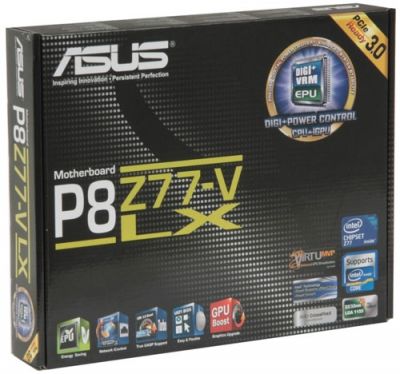
Inside the box there is a mainboard in the anti-static bag, and all accessories are arranged beneath the board and a cardboard separator pad. Everything seems to be quite common, but the cardboard sheet between the board and the accessories is noticeably longer and one of its sides is folder over the board creating some sort of a pocket. This pocket contains relatively thick SATA cables, while beneath the cardboard sheet you will find only the back panel I/O Shield, a DVD disk and instruction manuals, which barely take up any space in the box. This creative approach allowed significantly reducing the package thickness.
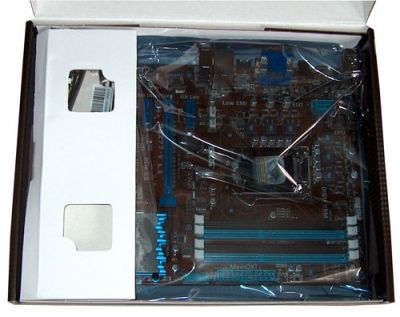
We have listed almost all the included accessories in the paragraph above:
- Two Serial ATA cables with metal connector locks;
- I/O Shield for the back panel;
- User manual;
- Brief assembly instructions booklet in multiple languages;
- Reliability certificate listing all component testing methods;
- DVD disk with software and drivers;
- “Powered by Asus” sticker for the system case.
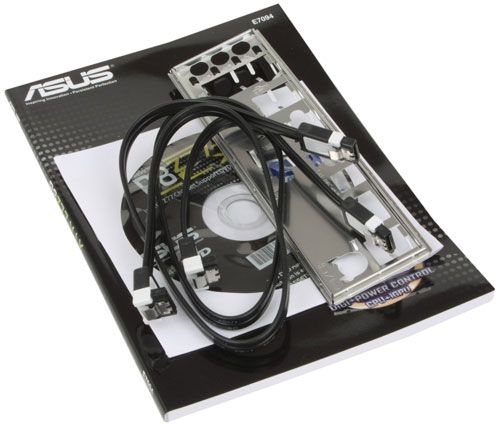
PCB Design and Functionality
Asus P8Z77-V LX mainboard looks quite common, although it does boast a few distinguishing features. The first thing we notice is the smaller mainboard dimensions. While the length of the PCB remains at standard 305 mm, it is only 218 mm wide, which is narrower than the 244 mm of the ATX standard.
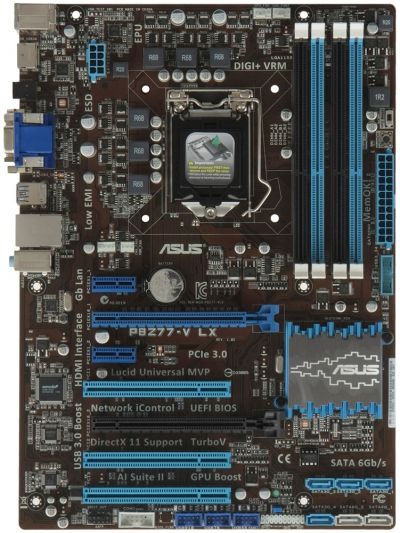
I would also like to point out that there are no heatsinks on the processor voltage regulator circuitry components. However, it doesn’t cause any issues during overclocking or mainboard’s operation in nominal mode, because the DIGI+ digital voltage regulator working as 4+1+1 doesn’t heat up that much. As for the memory, Asus P8Z77-V LX mainboard doesn’t differ from any other models in this aspect and allows installing up to 32 GB into four DIMM slots. The supported memory frequency range for Ivy Bridge processors starts at 800 MHz and ends at 3200 MHz. There are no additional drive controllers, which are so popular among mainboard makers. The board has two SATA 6 Gbps ports (light-gray connectors) and four SATA 3 Gbps ports (light-blue connectors), which are implemented in the Intel Z77 Express chipset.
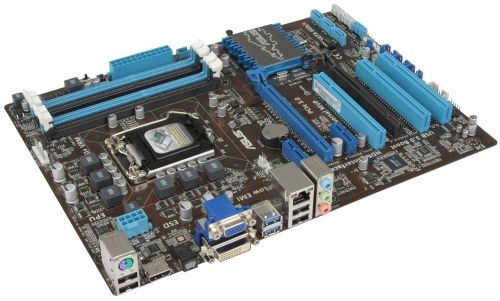
There are two PCI Express x16 slots for graphics cards, but the mainboard doesn’t use the chipset’s ability to distribute the processor PCI Express lanes between the slots evenly. All existing 16 lanes are solely at the disposal of the top PCI Express 3.0/2.0 x16 slot. The second PCI Express 2.0 x16 slot uses four chipset lanes. There is no Nvidia SLI support, but you can use these two slots to build AMD CrossFireX configurations. Besides them, there are two PCI Express 2.0 x1 and three PCI slots for other expansion cards.

The mainboard back panel contains the following ports and connectors:
- Universal PS/2 connector for keyboard or mouse;
- Four USB 2.0 ports, another six ports are laid out as three onboard pin-connectors;
- HDMI, D-Sub and DVI-D video outs;
- Optical S/PDIF and three analogue audio-jacks provided by eight-channel Realtek ALC887 codec;
- Two USB 3.0 ports (blue connectors) and one onboard pin-connector for additional two USB 3.0 ports implemented in the Intel Z77 Express chipset;
- Local network port (network adapter is built on Gigabit Realtek RTL8111E controller).
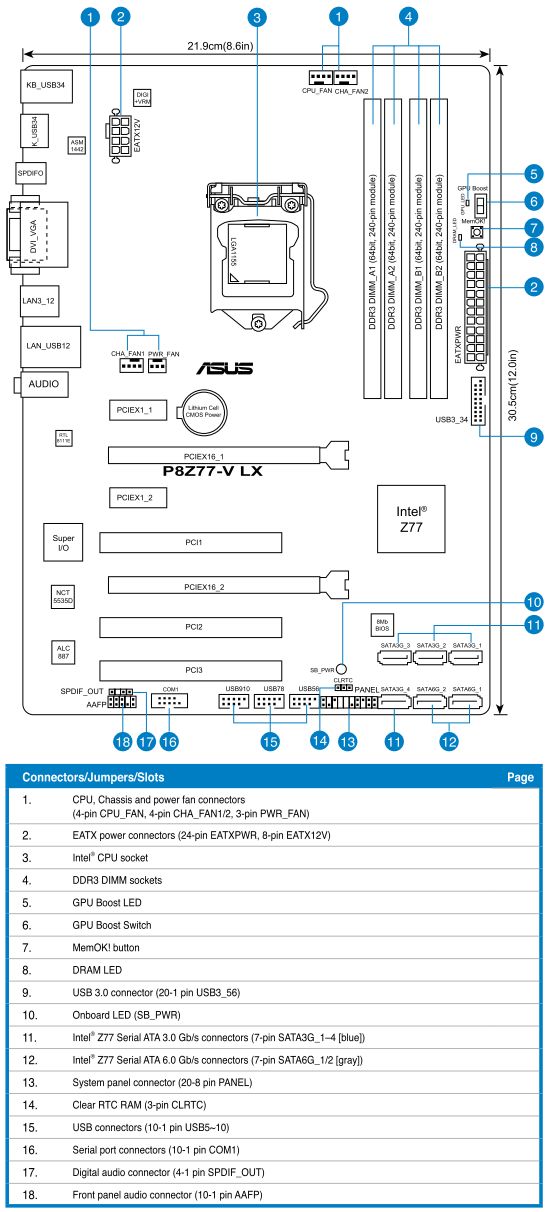
I would like to point out that Asus P8Z77-V LX has very wide and convenient Q-Slot latches on the graphics card slots, but the DIMM slots are of classical design. The MemOK! button is still there and it allows the board to boot successfully even if there are problems with the system memory. The new thing is the “GPU Boost” switch, which allows automatically increasing the frequency of the graphics core integrated into the processor. Out of all Q-Led diodes that help identify the start-up issues, there is only DRAM LED left. Two other diodes are “Standby Power LED” and “GPU Boost LED”.
We summed up the mainboard’s major technical specifications in the following table:
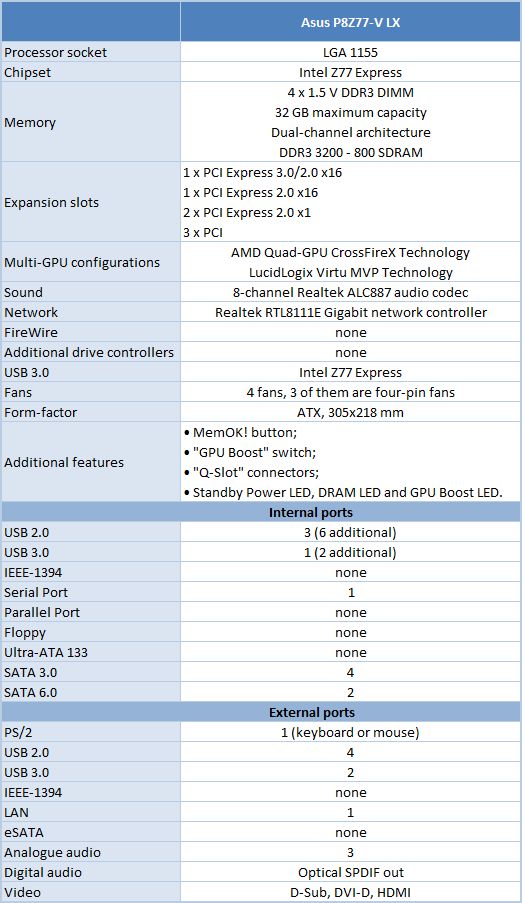
We don’t have anything to point out regarding the mainboard design or functionality, although there are indeed a few little issues. The back panel looks kind of empty, there are only three audio-jacks and to fully utilize the functionality of the eight-channel codec you will have to use the audio ports on the system case front panel. The fan connectors are not in the best spots. There are four of them, which is more than enough for an entry-level mainboard, but they are placed in pairs at the top and in the center of the PCB close to the back panel connectors. It would be nice to have at least one fan connector in the lower right corner of the PCB for additional cooling of the drives. However, despite these little comments, the board is overall very good and its functionality will be more than sufficient for the majority of users.
BIOS Functionality
In our previous reviews of Asus products we have already talked about Asus EFI BIOS – an overall very successful implementation of the UEFI standard (Unified Extensible Firmware Interface). Therefore, today we are going to just briefly glance over the major BIOS sections.
By default, there is “EZ Mode” enabled in the BIOS. It performs mostly informational functions, because there are barely any configurable parameters there. You can check the basic system settings, some monitoring data, select an energy-efficient or performance mode and set the order of boot-up devices by simply dragging and dropping them with the mouse pointer.
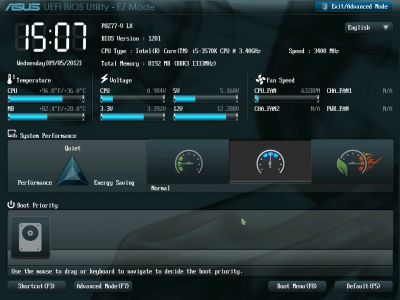
You can quickly switch from “EZ Mode” to “Advanced Mode” by pressing F7, or use the F3 hot key to jump over to one of the most frequently used BIOS sections.
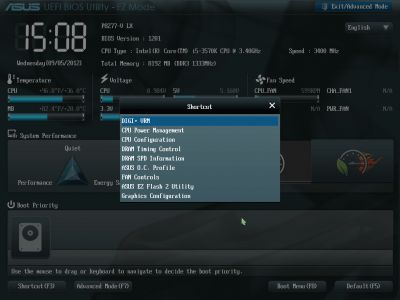
You can switch from “EZ Mode” to “Advanced Mode” every time you enter the BIOS, or press F3 key which also works if pressed while in any other BIOS section, yet it could be much more convenient if you made “Advanced Mode” a default setting. In this case the first section you see will be the familiar “Main” section, where you can receive some basic system information, change the interface language and set up date and time.
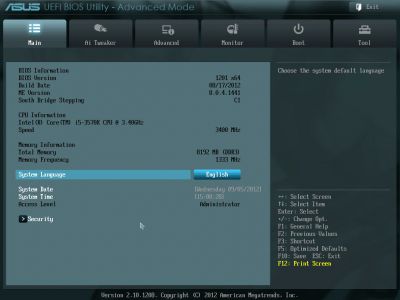
Most of the overclocking-related options are traditionally gathered in the “Ai Tweaker” section. The main section window allows you to change the frequencies, multipliers and voltages. You don’t need to go over to the “Monitoring” section to check the current voltages, as they are all listed right here next to each of the parameters used for changing these voltages, which is highly convenient. The voltage may be set above or below their nominal values.
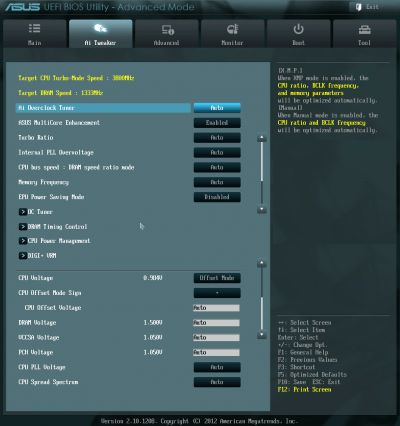
As usual, some parameters are singled out into individual sub-sections in order to unload the main section a little bit. “OC Tuner” parameter only looks like a sub-section, but in reality it helps to automatically overclock the system. The memory timings can also be configured on an individual page. They are indeed very numerous, but still very easy to work with. You can see all timings that the mainboard sets for each of the two memory channels. And you can adjust only a few selected timings, such as the main ones, for example, leaving all other settings at defaults.
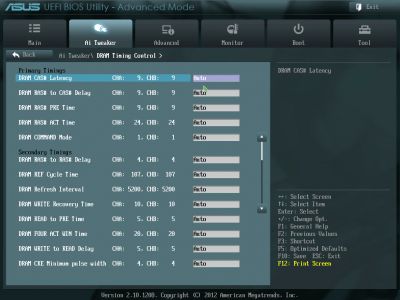
The “CPU Power Management” sub-section allows configuring the parameters affecting “Intel Turbo Boost” technology. However, you do not have to do that, because the board will automatically adjust everything to match your selected overclocking goals.
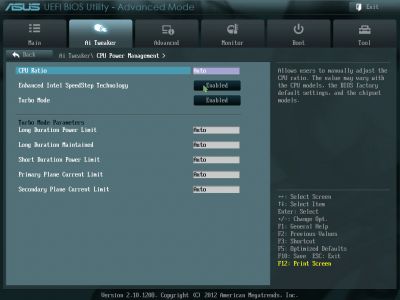
There are significantly fewer options related to the power and energy-efficiency of the digital DIGI+ voltage regulator than you will find by other Asus mainboards. However, all the most important ones are here. You can configure Asus’ proprietary power-saving technologies that allow changing the number of active phases in the voltage regulator circuitry depending on the CPU utilization right in the BIOS. “CPU Load-Line Calibration” technology that prevents the CPU Vcore from dropping under heavy load may be not only enabled or disabled, but also adjusted to deliver the desired effect.
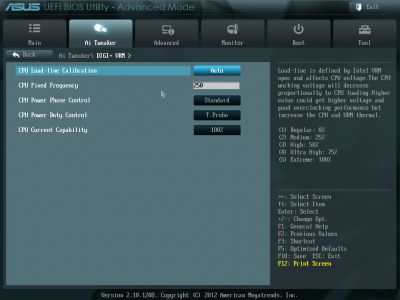
The functionality of the parameters in the sub-sections of the “Advanced” section is quite clear from their names.
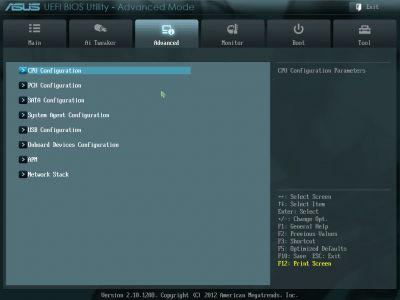
The “CPU Configuration” sub-section reports the basic info about the processor and allows managing some processor technologies.
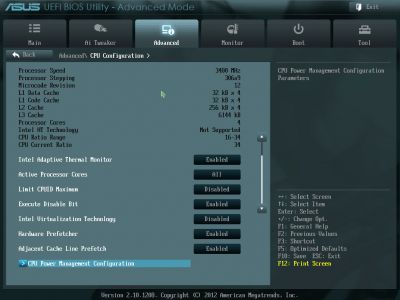
All parameters related to power-saving are singled out on a separate page called “CPU Power Management Configuration”.
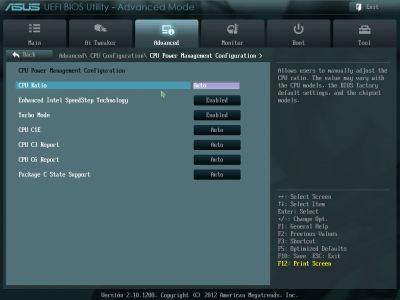
“Monitor” section tells us the current temperatures, voltages and fan rotation speeds. You can select one of the preset modes for the processor and two case fans from a pretty standard list including “Standard”, “Silent” and “Turbo” modes. You can also select the parameters manually. Both case fan connectors allow adjusting the fans rotation speeds even if you are using three-pin fans, unlike the processor fan connector. And the three-pin “Power Fan” connector doesn’t support any rotation speed adjustment at all and only reports the RPM of the fan connected to it.
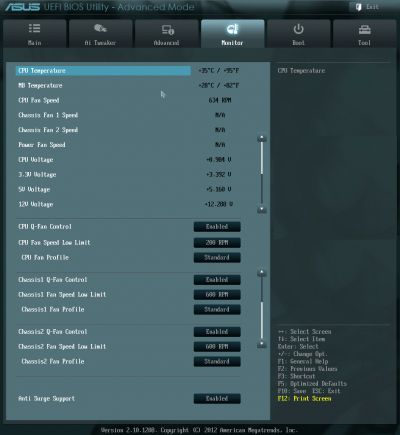
The “Boot” section allows you to adjust your boot-up parameters that will be applied on system start-up. By the way, this is where you have to replace the default “EZ Mode” with “Advanced Mode”.
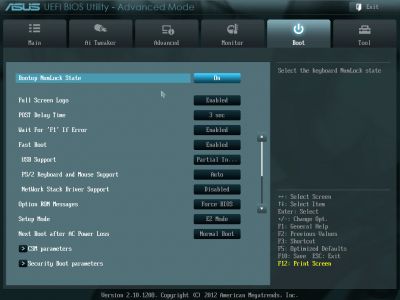
Now let’s quickly refresh the functionality of the “Tools” section.
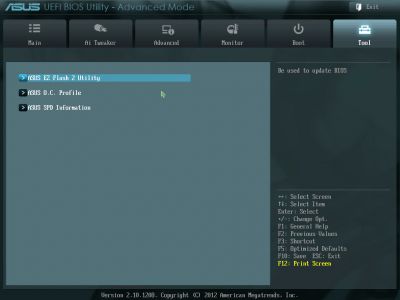
The built-in “EZ Flash 2” utility for BIOS reflashing is one of the most convenient and functional programs of the kind. Unfortunately, they have recently eliminated the option that allowed saving the current BIOS version before reflashing a new one.
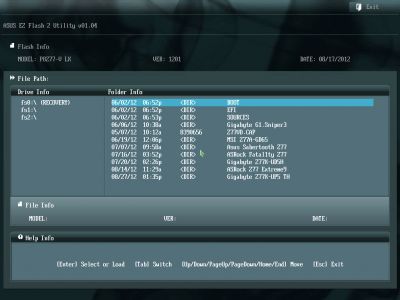
Asus mainboards allow saving and then quickly loading eight full BIOS settings profiles. Each profile may be given a brief descriptive name reminding you of its contents. They still haven’t fixed the issue that doesn’t allow you to save disabling of the startup image in the settings profile, but they brought back the ability to exchange BIOS settings profiles with other users, which was lost upon transition to the EFI BIOS. From now on the profiles may be saved onto external media and loaded from them.
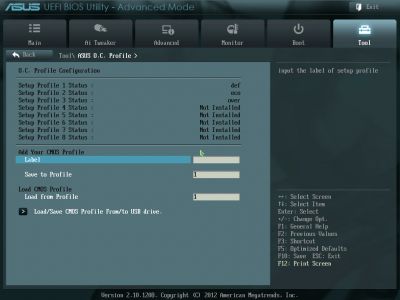
Just like on mainboards from many other makers we can read the information in the memory modules SPD.
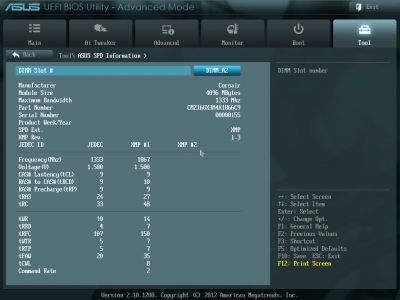
The last section is called “Exit”. Here you can apply the changes, restore the defaults or go back to the “EZ Mode”.
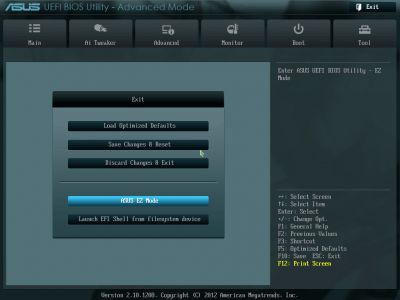
Testbed Configuration
We carried out our tests on a testbed that included the following components:
- Asus P8Z77-V LX mainboard (LGA 1155, Intel Z77 Express, BIOS version 1201);
- Intel Core i5-3570K CPU (3.6-3.8 GHz, 4 cores, Ivy Bridge rev.E1, 22nm, 77 W, 1.05 V, LGA 1155);
- 2 x 4 GB DDR3 SDRAM Corsair Vengeance CMZ16GX3M4X1866C9R (1866 MHz, 9-10-9-27 timings, 1.5 V voltage);
- Gigabyte GV-T797OC-3GD )AMD Radeon HD 7970, Tahiti, 28 nm, 1000/5500 MHz, 384-bit GDDR5 3072 MB);
- Crucial m4 SSD (CT256M4SSD2, 256 GB, SATA 6 Gbps);
- Scythe Mugen 3 Revision B (SCMG-3100) CPU cooler;
- ARCTIC MX-2 thermal interface;
- Enermax NAXN ENM850EWT PSU;
- Open testbed built using Antec Skeleton system case.
We used Microsoft Windows 7 Ultimate SP1 64 bit (Microsoft Windows, Version 6.1, Build 7601: Service Pack 1) operating system, Intel Chipset Software Installation Utility version 9.3.0.1020, AMD Catalyst 12.4 graphics card driver.
Operational and Overclocking Specifics
When we assembled our Asus P8Z77-V LX based system we didn’t have any problems or difficulties. We also didn’t experience any issues during the installation of the operating system, reflashing the BIOS or just using the system in the nominal mode with the default settings. During system startup we see a startup image, but there is no mention of any hot keys on it.

Disabling the startup image won’t bring the hot key reminders to the screen. Moreover, the board can’t tell us the actual CPU clock frequency, and will always report the nominal one. However, it does read the memory size and frequency absolutely correctly.
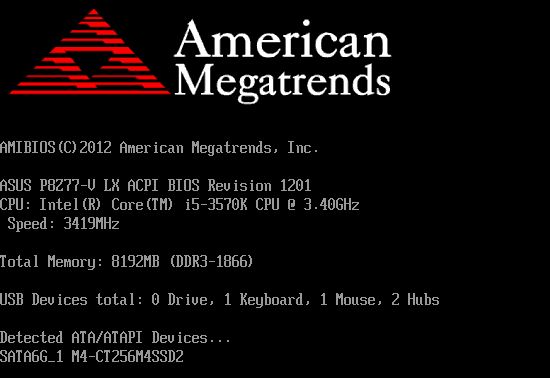
In the latest reviews of ASRock mainboards we pointed out that they started and rebooted very fast. The BIOS of Asus P8Z77-V LX mainboard as well as the BIOS of other Asus’ boards, allows setting the startup delay (at 3 seconds by default). And as for rebooting, the board does it simply instantaneously. It actually happens so fast that we sometimes had hard time accessing the BIOS to correct any of the settings. The board flies through the startup process and sometimes we would only stop it in the beginning of the OS loading.
Although this is not one of Asus’ flagship products, it does have some overclocking-friendly functionality, including automatic overclocking. The easiest way to overclock is to use “Asus MultiCore Enhancement” function, which allows increasing the processor clock frequency multiplier to the maximum allowed by Intel Turbo Boost technology under any type of operational load. I think it makes sense to remind you where this parameter comes from in Asus mainboards.
About a year ago in our Asus Maximus IV Extreme Mainboard Review we pointed out that this board always increased the processor clock frequency multiplier to the maximum allowed by Intel Turbo Boost technology, which was only intended for single-threaded loads. Of course, we could be excited about this unexpected CPU overclocking, but we would prefer to have the control over the choice of non-standard operation modes. We would prefer to be able to make our own informed decision instead of being forced into this mode, and to have the system in nominal mode work the way it is supposed to. This was the reason why we didn’t like this peculiarity back then. Luckily, there was a way to get Asus Maximus IV Extreme mainboard to work in nominal mode properly. We ran our standard set of tests and now we don’t really know what’s going on and if this issue has been fixed, because at that time it was one of the last LGA 1155 mainboard reviews.
A little later we moved on to LGA 2011 boards and discovered that there was a continuation to this story. There appeared a new F6 functional key in Asus mainboards BIOS, which was used to activate “Asus Ratio Boost” automatic overclocking technology. When this parameter was on, it increased the processor clock frequency multiplier to the maximum allowed by Intel Turbo Boost technology, and in the nominal mode the processor was working as the specifications declared. Everything seemed to be exactly the way we wanted, but this particular implementation did have one small problem. We rarely pay attention to the list of hot keys in the lower right corner of the BIOS screen, and therefore, we didn’t notice this new function until we started reviewing Asus Rampage IV Formula mainboard. In the meanwhile, Asus P9X79 Deluxe already had this same exact feature, although we dind’t notice it during the review process.
So, the appearance of the new “Asus MultiCore Enhancement” parameter in the main parameter list, which we pointed out in our Asus P8Z77-V Deluxe mainboard review, became a logical conclusion to this story. It is possible to allow the processor clock frequency multiplier to increase to the maximum as approved by the Intel Turbo Boost technology under any type of operational load, or to disable this feature. This parameter is very visible, but has a few peculiarities of its own. Although it is set at “Enable” by default, it doesn’t affect the CPUs working in nominal mode. Only if you change the nominal system settings, for example, use the X.M.P. profile for the memory, the function kicks in and boosts the overall speed by slightly overclocking the processor.
However, this is not the only thing the board is capable of in terms of automatic overclocking. You can also use “OC Tuner” parameter, which will produce an ever better result. In our case the base clock frequency was increased to 103 MHz, which affected all frequencies connected with it, such as the memory clock frequency, and the processor clock multiplier was increased to 41x. Together with the effect from higher base clock this pushed the resulting CPU frequency to 4224 MHz. It is important to point out that all processor power-saving technologies lowering the processor clock frequency multiplier and core voltage in idle mode continued working just fine.
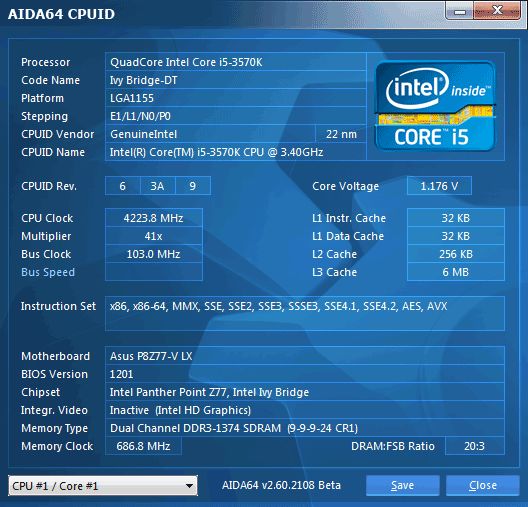
However, everyone knows that no automatic overclocking can be as effective as manual search for the most optimal parameters. Unfortunately, the mainboard didn’t let us overclock our test processor to its maximum frequency of 4.6 GHz, but it easily reached 4.5 GHz. The memory frequency was also increased.
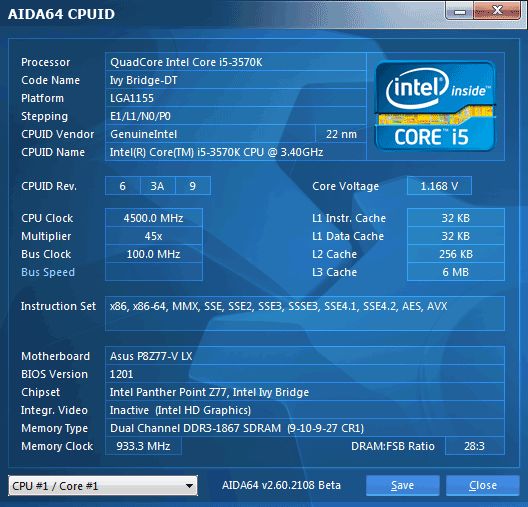
Now I would only like to remind you that we always overclock mainboards in such a way that they could be used for a prolonged period of time in this mode. We do not try to make our life easier by disabling any of the mainboard features, such as onboard controllers, for example. We also try to keep the CPU’s power-saving technologies up and running normally to the best of our ability. And this time all power-saving technologies remained up and running even during overclocking lowering the CPU voltage and frequency multiplier in idle mode.
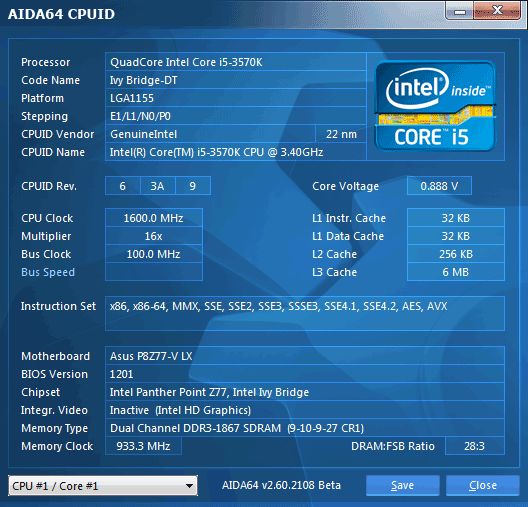
Performance Comparison
As usual, we are going to compare the mainboards speeds in two different modes: in nominal mode and during CPU and memory overclocking. The first mode is interesting because it shows how well the mainboards work with their default settings. It is a known fact that most users do not fine-tune their systems, they simply choose the optimal BIOS settings and do nothing else. That is why we run a round of tests almost without interfering in any way with the default mainboard settings. For comparison purposes we also included the results of the previously reviewed mainboards:
- ASRock Fatal1ty Z77 Professional
- ASRock Z77 Extreme4 and ASRock Z77 Extreme6
- ASRock Z77 Extreme9
- Asus P8Z77-V Deluxe
- Asus Sabertooth Z77
- Gigabyte G1.Sniper 3
- Gigabyte GA-Z77X-UD3H and GA-Z77X-UD5H-WB WIFI
- Gigabyte GA-Z77X-UP4 TH and Gigabyte GA-Z77X-UP5 TH
- Intel DZ77BH-55K
- Intel DZ77GA-70K and Intel DZ77RE-75K
- MSI Z77A-GD65.
The results on the diagrams are sorted out in descending order.
Nominal Mode
We used Cinebench 11.5. All tests were run five times and the average result of the five runs was taken for the performance charts.
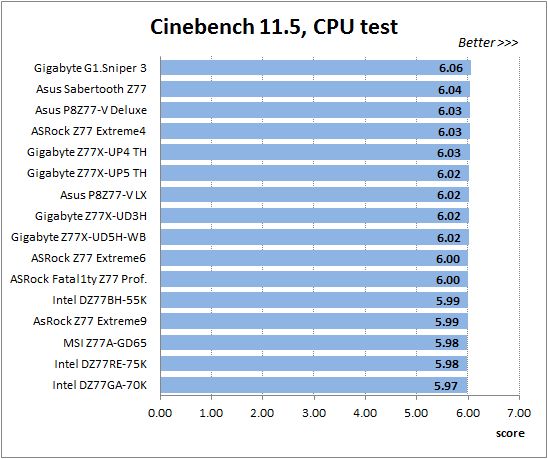
We have been using Fritz Chess Benchmark utility for a long time already and it proved very illustrative. It generated repeated results, the performance in it is scales perfectly depending on the number of involved computational threads.
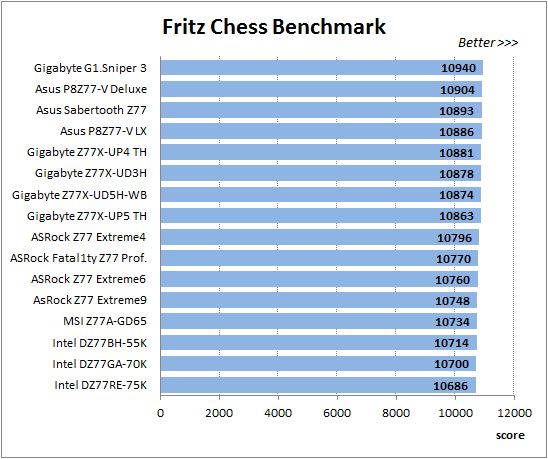
A small video in x264 HD Benchmark 4.0 is encoded in two passes and then the entire process is repeated four times. The average results of the second pass are displayed on the following diagram:
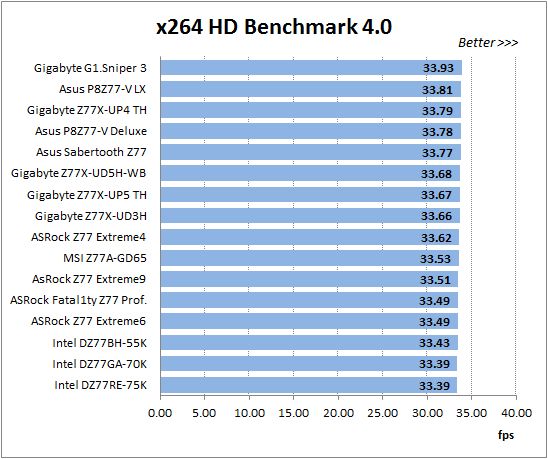
We measured the performance in Adobe Photoshop using our own benchmark made from Retouch Artists Photoshop Speed Test that has been creatively modified. It includes typical editing of four 10-megapixel images from a digital photo camera.
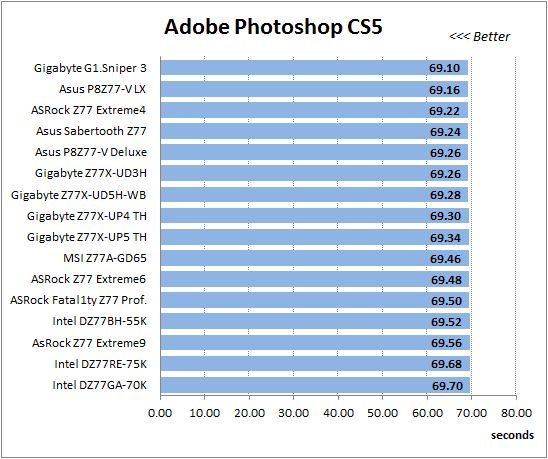
In the archiving test a 1 GB file is compressed using LZMA2 algorithms, while other compression settings remain at defaults.
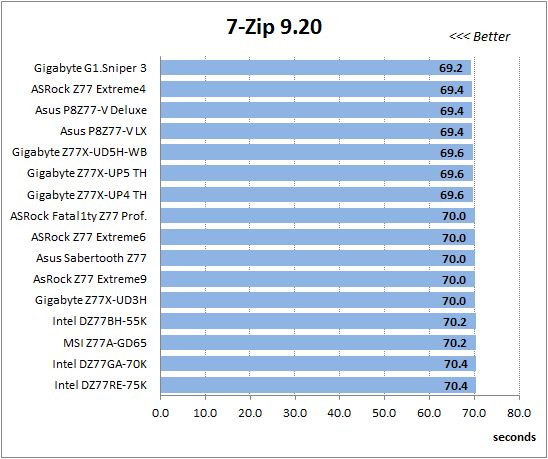
Like in the data compression test, the faster 16 million of Pi digits are calculated, the better. This is the only benchmark where the number of processor cores doesn’t really matter, because it creates single-threaded load.
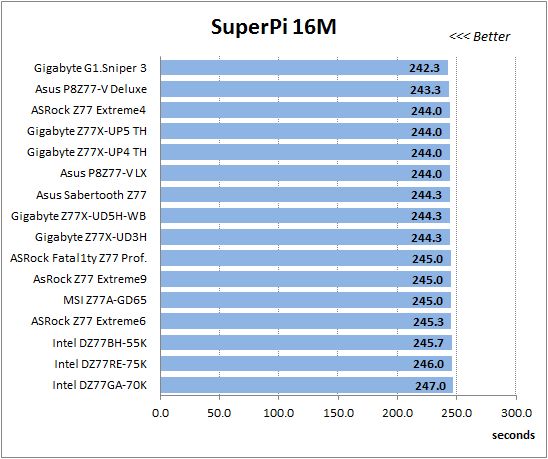
Since we do not overclock graphics in our mainboard reviews, the next diagram shows only CPU tests from the 3DMark11 – Physics Score. This score is obtained in a special physics test that emulates the behavior of a complex gaming system working with numerous objects:
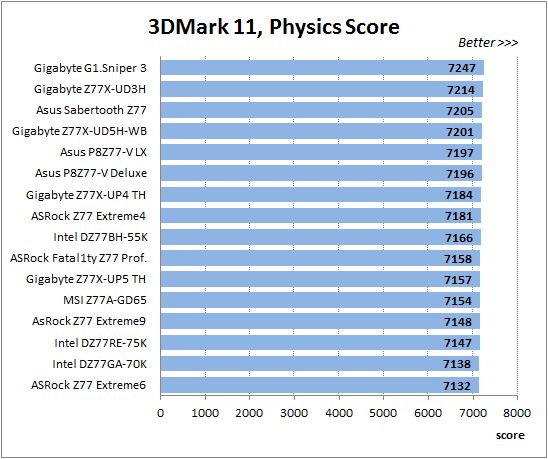
We use FC2 Benchmark Tool to go over Ranch Small map ten times in 1920×1080 resolution with high image quality settings in DirectX 10.
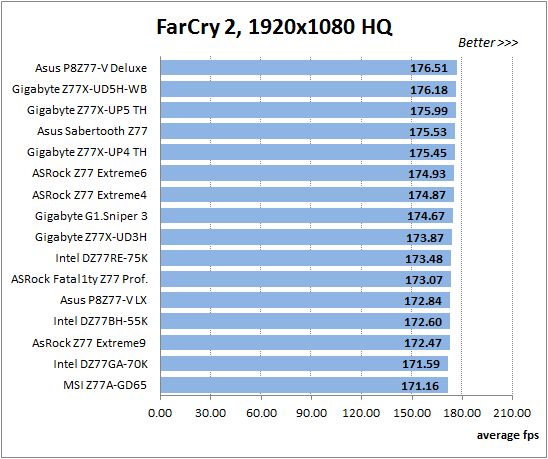
Resident Evil 5 game also has a built-in performance test. Its peculiarity is that it can really take advantage of multi-core processor architecture. The tests were run in DirectX 10 in 1920×1080 resolution with high image quality settings. The average of five test runs was taken for further analysis:
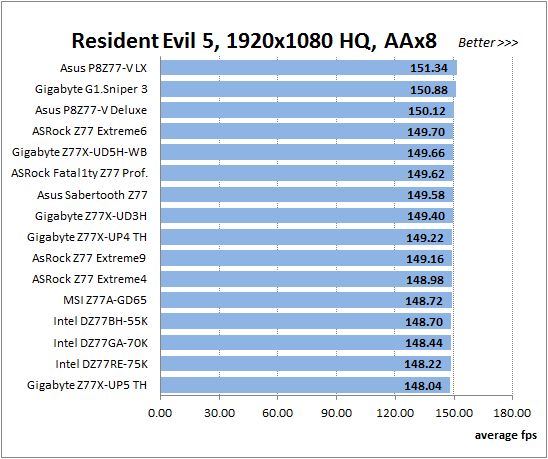
Batman: Arkham City game also reacts eagerly to any changes in the CPU clock frequency, but it uses DirectX 11. We ran game’s integrated benchmark five times with high image quality settings and then take the average of the five runs for the diagrams.
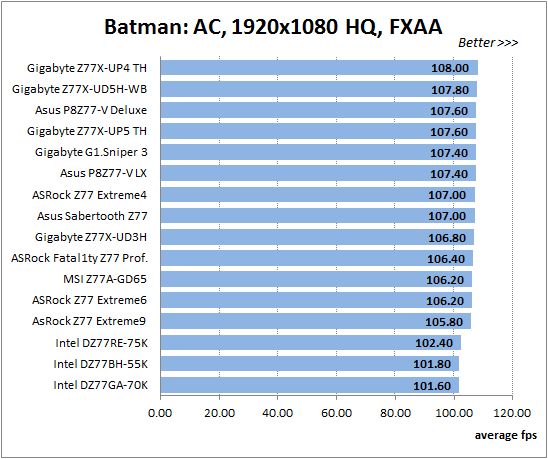
In the nominal mode Asus P8Z77-V LX performs very well, which is a little above average in most cases. Only in Far Cry 2 game the board for some reason scored less than we had expected. However, the result wasn’t too critical anyway and the performance difference from other testing participants wasn’t dramatic.
Overclocked Mode
Things change a little bit during overclocking, because the board couldn’t overclock processor to its maximum. The obtained results of our processor and memory overclocking experiments are summed up in the following table:
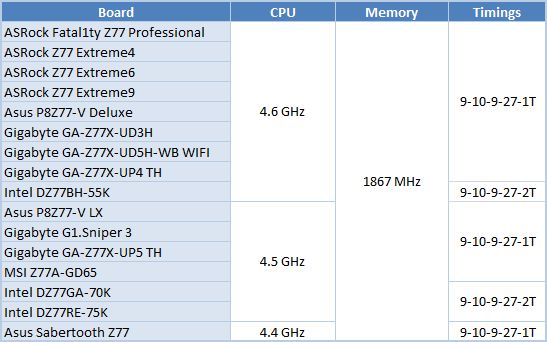
Asus P8Z77-V LX occupies a steady position in the group of mainboards, which overclocked the processor to the same 4.5 GHz frequency. Moreover, it does better than expected in gaming benchmarks. It even manages to outperform some of the mainboards, which achieved better processor overclocking results.
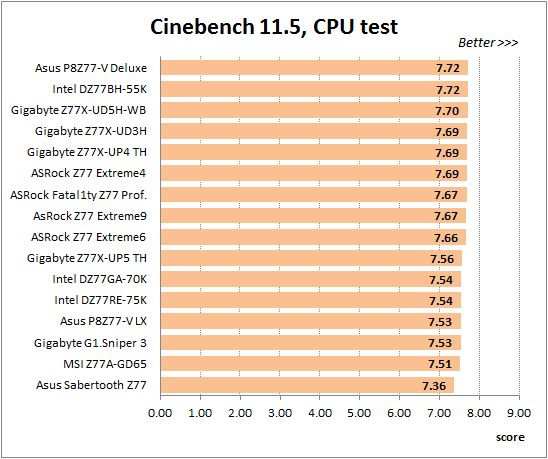
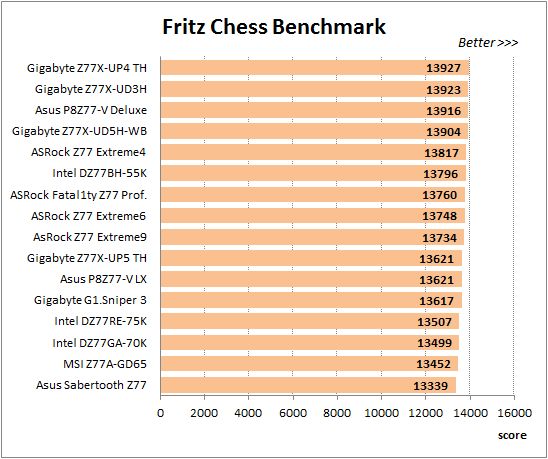
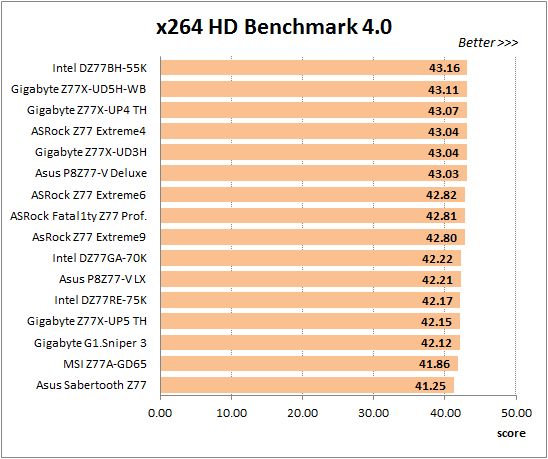
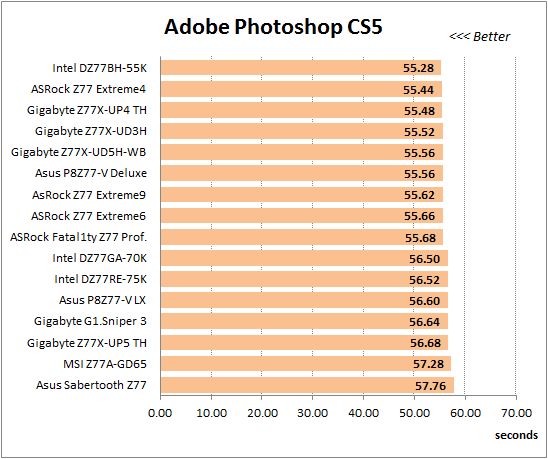
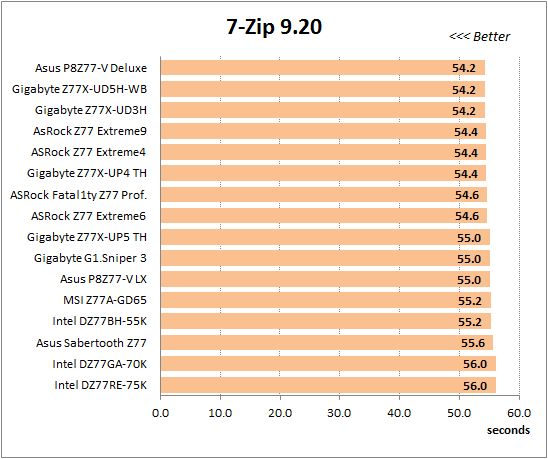
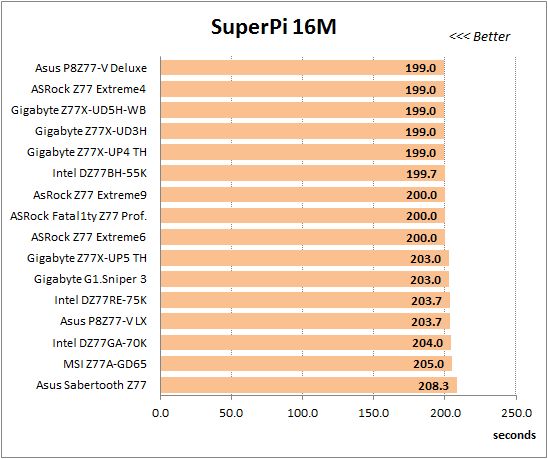
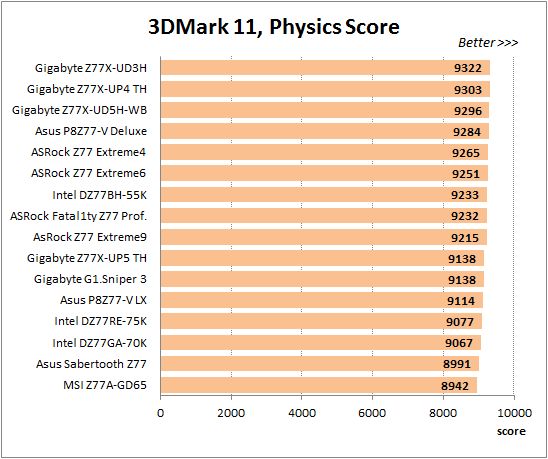
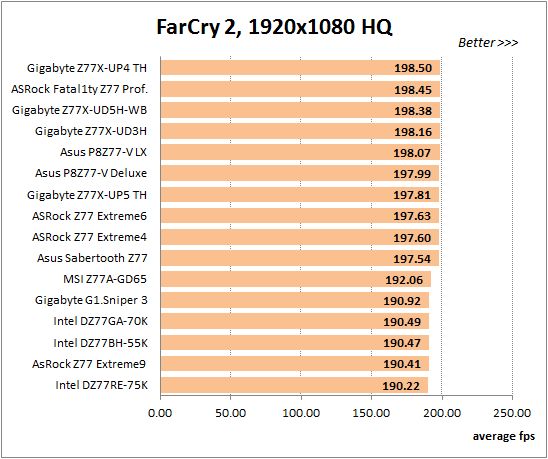
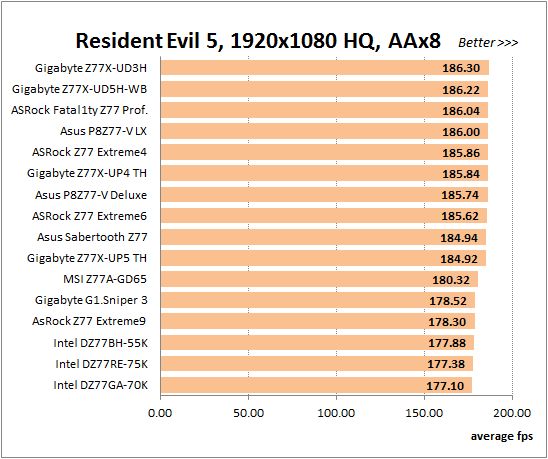
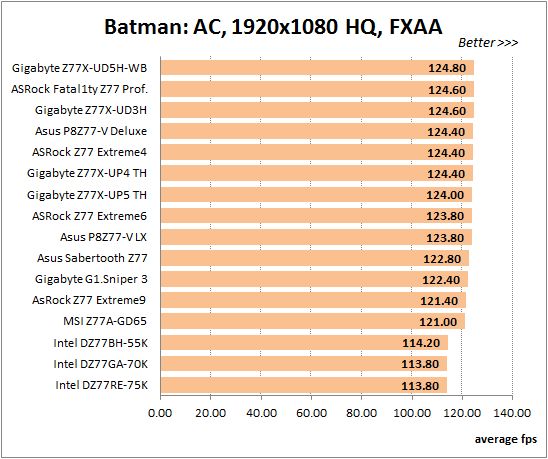
Power Consumption
We performed our power consumption measurements using an Extech Power Analyzer 380803. This device is connected before the PSU and measures the power draw of the entire system (without the monitor), including the power loss that occurs in the PSU itself. In the idle mode we start the system up and wait until it stops accessing the hard disk. Then we use LinX to load the CPU. For a more illustrative picture there are graphs that show how the computer power consumption grows up depending on the number of active execution threads in LinX (both at the default and overclocked system settings).
Because of compatibility issues we uncovered with Gigabyte GA-Z77X-UP4 TH and Gigabyte GA-Z77X-UP5 TH mainboards with our original CoolerMaster RealPower M850 power supply unit, we had to replace it with Enermax NAXN ENM850EW. Both these PSUs have very similar technical characteristics, but Enermax NAXN ENM850EWT is about 1-3 W more energy-efficient than the Cooler Master unit. In order to be able to use the previously obtained results, we decided to make up for this efficiency difference by adding 2 W to all new power readings, so that we could still compare their results against the power consumption of all previously tested products.
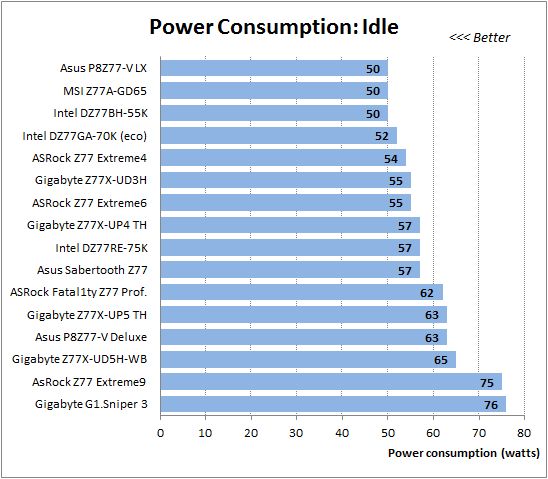
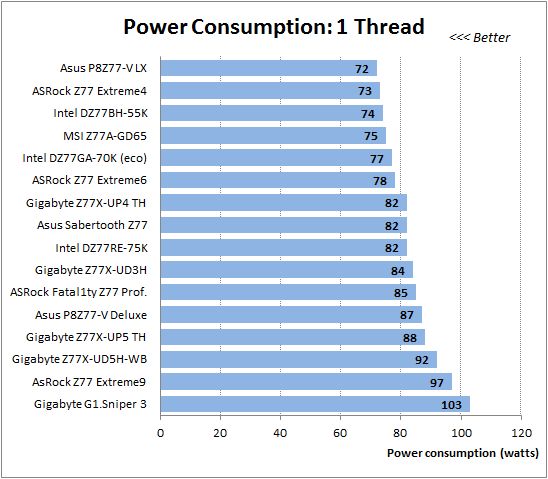
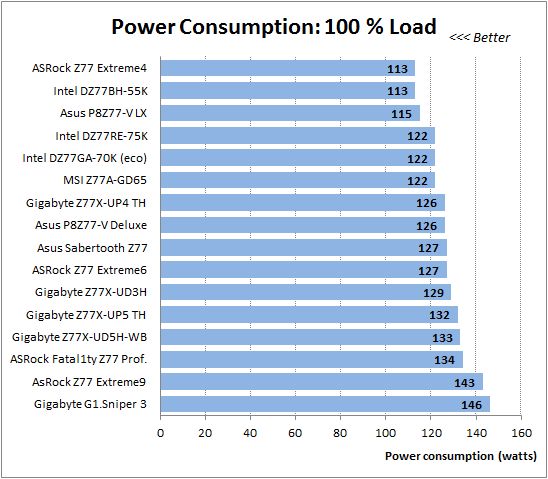
There was a time when we used to repeat that Asus mainboards weren’t particularly energy-efficient and consumed more power than others. It is indeed so, when we are talking about flagship models with extended functionality and numerous onboard controllers. However, the charts show that there are in fact quite a few mainboards from other manufacturers, which consume more than Asus boards. But once we take a board like Asus P8Z77-V LX, it immediately falls into the energy-efficient category. Moreover, its power consumption may be further reduced by enabling all power-saving options in the BIOS, including the proprietary “EPU Power Saving Mode”.
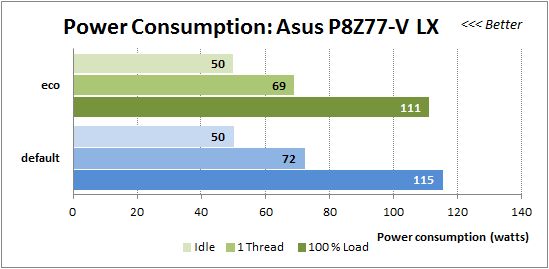
The situation doesn’t change during overclocking and Asus P8Z77-V LX remains among the most energy-efficient boards. Of course, we should keep in mind that quite a few boards overclocked the processor better and that is why they consume more power. However, Asus P8Z77-V LX looks great even among those boards that achieved the same overclocking results.
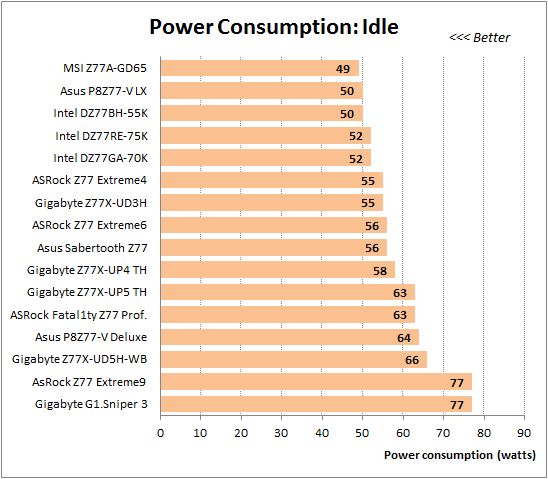
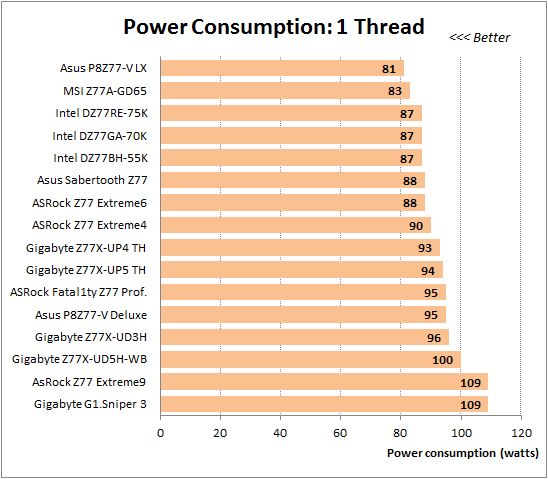
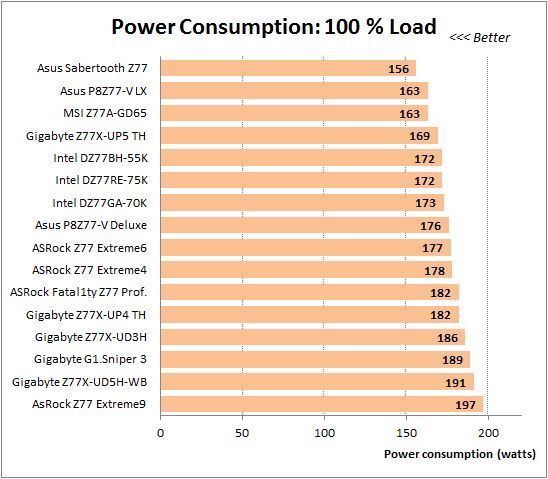
Conclusion
I have to say that Asus P8Z77-V LX made a very good overall impression. It comes with modest accessories bundle, doesn’t have additional onboard controllers, doesn’t have any heatsinks on the processor voltage regulator components, and doesn’t use the chipset’s ability to distribute the processor PCI Express lanes evenly. But there is nothing wrong about any of this. Intel Z77 Express chipset used in this mainboard provides quite rich functionality. Many users do not need eSATA and IEEE1394 (FireWire) ports, a second network controller or additional drive controllers. They use one graphics accelerator and therefore, one PCI Express 3.0/2.0 x16 slot will be more than enough for their needs. This is an almost ideal mainboard for a mainstream user, although the back panel could have been a little busier and the fan connectors could have been placed in somewhat better spots. As for the BIOS functionality, it is practically the same as on other Asus mainboards and the lack of additional heatsinks didn’t prevent Asus P8Z77-V LX from overclocking the processor and memory quite well. In nominal mode and during overclocking the board performs better than average, and in terms of power consumption it often becomes the leader of the pack, i.e. it is very energy-efficient.
I sincerely regret that Asus P8Z77-V LX is not in fact based on the Intel Z75 Express chipset. In this case it would hardly lose anything in terms of features, except Intel Smart Response, but it would have become much more affordable in terms of price. Price is a very important factor for entry-level systems, and even though Asus P8Z77-V LX ended up being pretty inexpensive, its price is still a little higher than we would have wanted it to be in an ideal world. There are a lot of mainboards from other manufacturers with comparable or even better functionality, and the same or even lower price. As usual, the choice is all yours to make.